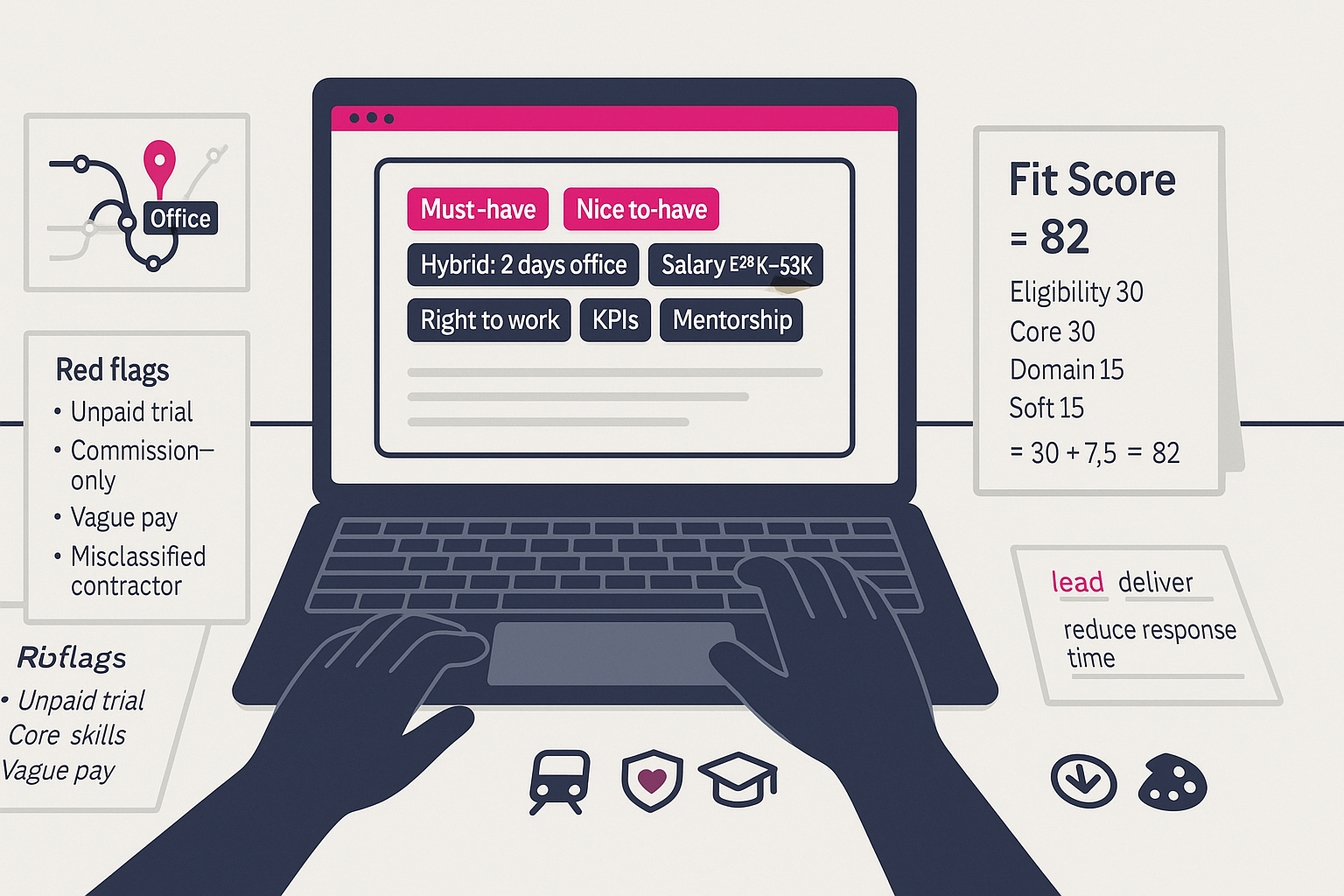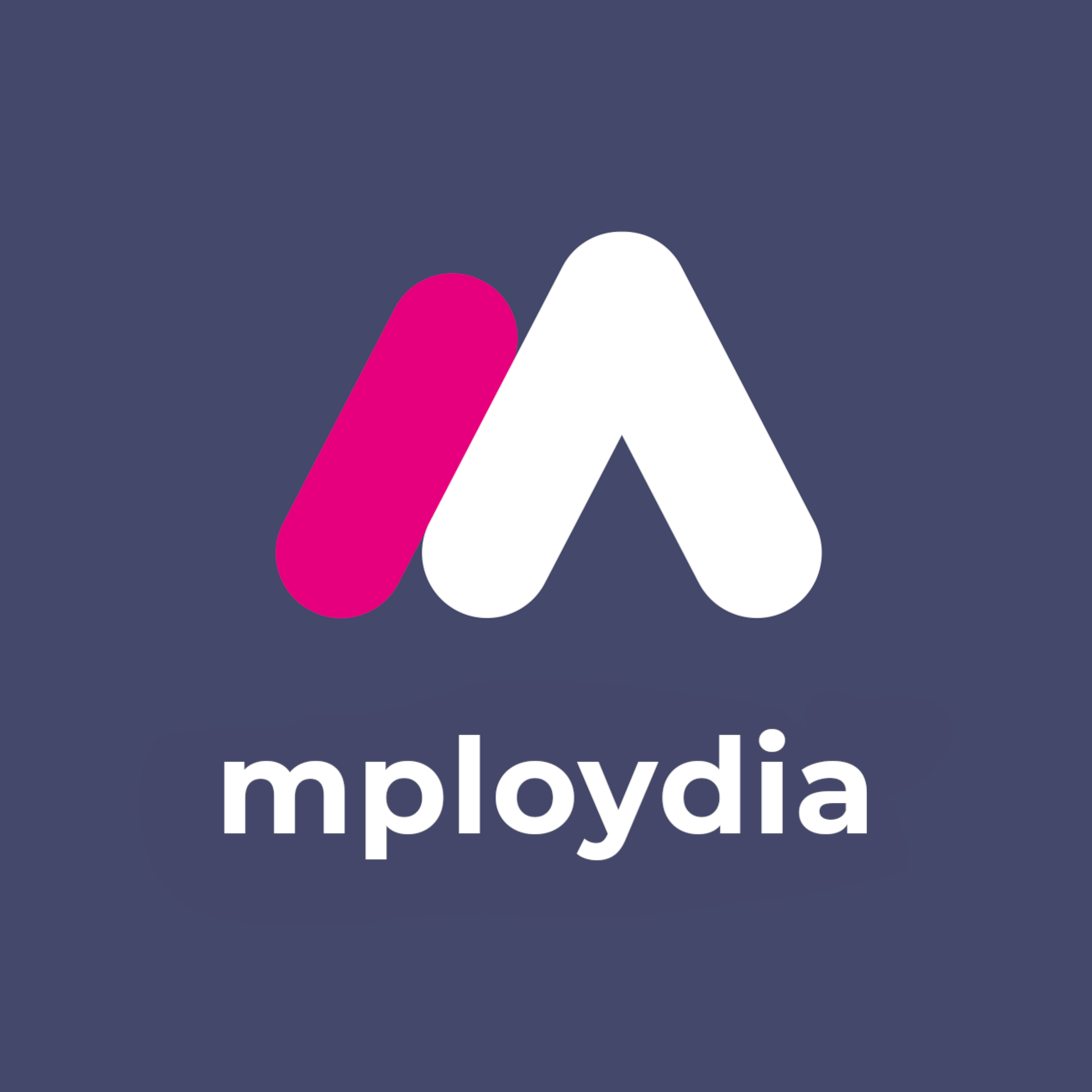
Decode Job Adverts for Fit: The Practical Graduate's Guide
Introduction
Job adverts can read like riddles. Vague buzzwords. Endless lists. Conflicting expectations. If you are trying to land your first job, misreading an advert wastes time and kills momentum. This guide shows you how to decode job adverts quickly and accurately so you can decide whether to apply, how to tailor your CV, and what to ask before saying yes. Expect direct, actionable steps, grounded in the UK job market.
The anatomy of a job advert
Job title and level
Titles vary across companies. Decode them, do not assume. Here is how to interpret common labels:
- Graduate, Trainee, Entry-level: Usually genuine first-job roles. Check for structured training, mentoring, and realistic experience demands.
- Junior, Associate, Coordinator: Often early-career but may require 1 to 2 years experience. Look for whether tasks are executional or strategic.
- Assistant: Can be administrative support or a genuine pathway role. Scan responsibilities for ownership vs admin-heavy tasks.
- Analyst, Executive, Specialist: Mixed bag. Read the responsibilities for scope, tools, and decision-making authority.
- Internship, Placement, Industrial Year: Check pay, duration, and learning outcomes. UK internships should pay at least National Minimum Wage unless they meet specific exceptions.
Company snapshot and mission
A strong advert anchors the role in the organisation’s purpose. Look for:
- What problem the team solves.
- Who the customers are.
- Where the role fits in the org structure.
If this is missing, expect ambiguity in scope and priorities.
Role summary
This should define outcomes, not just tasks. Strong examples mention delivering projects, hitting targets, improving a metric, or supporting a defined function. If the summary only lists tools and admin duties, expect limited development.
Responsibilities
Scan for ownership verbs and scope:
- Ownership signals: lead, deliver, own, drive, design, implement.
- Execution signals: support, assist, coordinate, maintain, update.
- Breadth signals: cross-functional, stakeholders, end-to-end, lifecycle.
Too many ownership verbs for a graduate role may indicate lack of support. Too many execution verbs may indicate a narrow, admin-heavy role. Balance matters.
Requirements: must-have vs nice-to-have
Adverts often mix the two. Separate them fast:
- Must-haves: legal requirements, certifications, non-negotiable technical skills, shift patterns, travel, right to work, specific language requirements if customer-facing.
- Nice-to-haves: desirables, exposure to tools, preferred frameworks, experience with specific industries, advanced certifications.
Tactic: Mark every requirement as Must, Strong, or Nice. Apply only if you satisfy all Musts and at least half of the Strong items. Do not self-eliminate based on Nice-to-haves.
Benefits and compensation
UK adverts may show salary ranges. Interpret them:
- If the range is tight, the company likely has clear bands.
- If there is no salary, check similar roles on Glassdoor, LinkedIn, and job boards.
- OTE (On-Target Earnings) means base plus commission. For first roles, confirm the guaranteed base.
- Benefits to look for: pension auto-enrolment, holiday allowance, sick pay, L&D budget, travel expenses, equipment, health cover.
Location, work pattern, and travel
- Remote, Hybrid, On-site: Hybrid often means 2 to 3 days in office weekly. Confirm the exact expectation.
- Travel: “Some travel” could mean monthly site visits or weekly client trips. Ask for frequency and expense policy.
- Shift patterns: Rotas, weekends, nights. Confirm hours and on-call arrangements.
Contract type
- Permanent: Usually includes probation and benefits.
- Fixed-term: Time-limited. Ask about extension or conversion.
- Temp or agency temp: Clarify holiday pay, notice, and assignment length.
- Apprenticeship: Formal training with assessments. Confirm level and wage.
Legal and compliance statements
- Right to work in the UK: If sponsorship is not offered, do not assume exceptions.
- Background checks: DBS for roles with vulnerable groups or financial responsibility.
- Equality statements: Positive sign, but evaluate whether they back it with actions.
Read between the lines: decode subtle signals
Culture and pace keywords
- Fast-paced, high-growth, ambiguity: Expect shifting priorities. Good for learners who can self-direct.
- Wear many hats, start-up environment: Broad exposure, limited structure. Ask about onboarding and mentoring.
- Structured, process-driven, regulated: Clear procedures and documentation. Good for consistent learning.
- Work hard play hard: Watch for long hours. Ask about workload and overtime policy.
Scope creep and workload
- Other duties as assigned: Normal, but excessive ambiguity can signal misaligned expectations.
- Flexible hours: Could mean autonomy or off-hours work. Ask for real examples.
- Immediate start: Often urgent hiring. Ask why the role is open.
Management, support, and training signals
- Reporting to: Who is your line manager. Seniority signals level of exposure.
- Mentoring, buddy, structured training: Good support. Ask for the first 90-day plan.
- Clear career path: Ask what promotion criteria look like and how often reviews happen.
Performance expectations
- KPIs, OKRs, SLAs, targets: Good roles define results. Ask what top performers achieve and what 6-month success looks like.
Tech and tool language
- Proficiency in: Expect hands-on ability.
- Experience with: Moderate level needed. Show projects or coursework.
- Familiarity with or exposure to: Basic knowledge acceptable. Demonstrate learning speed.
Build a Fit Score in 20 minutes
Use a simple weighted approach. Your goal is to decide fast, not to overthink.
Category weights
- Eligibility and logistics, 30 percent: Right to work, location, hours, travel, shift.
- Core skills, 30 percent: Technical or functional skills essential for the role.
- Domain knowledge, 15 percent: Industry, product area, regulations.
- Soft skills and behaviours, 15 percent: Communication, teamwork, initiative, problem-solving.
- Culture and support, 10 percent: Training, management style, pace.
Scoring steps
- Extract Musts and Strong items. Assign each item a weight within its category.
- Score your match per item from 0 to 1: 1 means you clearly meet it with proof. 0.5 means partial competence or transferable evidence. 0 means gap.
- Multiply item scores by weights. Sum to 100.
Decision rule
- 75 to 100: Strong fit. Apply and tailor deeply.
- 60 to 74: Conditional fit. Address gaps. Apply if learning support exists.
- 45 to 59: Stretch. Apply only if you can evidence fast learning and there is clear mentoring.
- Below 45: Probably skip unless there is a strong referral or rapid training promise.
Example Fit Score
A hybrid Marketing Assistant role, London, £26k to £28k, permanent. Requirements include right to work, 2 days in-office, Excel proficiency, copywriting basics, social scheduling tools, basic analytics, strong communication, attention to detail, interest in B2C e-commerce.
- Eligibility and logistics 30: Right to work 1.0, commute feasible 1.0, hybrid 1.0. Score 30.
- Core skills 30: Excel basics 0.8, copywriting basics 1.0, social tools 0.5, analytics basics 0.5. Weighted average 0.7. Score 21.
- Domain 15: B2C e-commerce knowledge 0.5. Score 7.5.
- Soft skills 15: Communication 1.0, attention to detail 0.8. Weighted average 0.9. Score 13.5.
- Culture and support 10: Mentoring promised 1.0. Score 10.
Total Fit Score: 82. Strong fit. Apply.
The 15-minute advert teardown workflow
Use a timer. Speed beats endless hesitation.
0 to 2 minutes: Skim and label the role
- Highlight the title, level, contract, salary, location, work pattern.
- Mark the team and line manager if listed.
3 to 6 minutes: Mark verbs and outcomes
- Circle verbs in responsibilities. Note ownership vs support.
- Capture 3 outcomes the role must deliver.
7 to 9 minutes: Extract Musts and Strong items
- Identify legal, logistical, and technical must-haves.
- Split desirables into Strong vs Nice-to-haves.
10 to 12 minutes: Validate externally
- Check LinkedIn company page and recent posts. Scan employee profiles for typical tools and backgrounds.
- Look at Glassdoor for culture and workload themes.
- Compare salary with similar roles on reputable UK job boards.
13 to 15 minutes: Decide and act
- If Fit Score 60 or above, move to application.
- Draft a quick tailoring plan for your CV and cover letter.
- List 5 clarification questions for the recruiter.
Reality check: verify beyond the advert
Do not rely solely on copywriting. Validate:
- Team size and structure on LinkedIn. If everyone is Senior, support may be light.
- Tenure patterns. High churn can indicate issues.
- Recent funding or product launches. High-growth might mean rapid role change.
- Salary benchmarks using multiple sources. Do not anchor on one data point.
- Right to work and sponsorship clarity. Ask explicitly if not stated.
Decide whether to apply: smart thresholds
Rules of thumb
- Meet 100 percent of Must-haves. Non-negotiable.
- Meet at least 60 to 70 percent of Strong items. Train for the rest.
- Ignore Nice-to-haves as selection blockers. They are not mandatory.
- If you have strong transferable evidence and support is offered, stretch roles can be worth it.
Self-deselection bias
Many candidates wrongly self-eliminate. If you meet the Musts and most Strong items, apply. Use your cover letter to close obvious gaps with proof of fast learning.
Tailor your application using what you decoded
Mirror keywords without lying
- Use the employer’s exact terminology for tools, methods, and outcomes.
- If they say stakeholder management, not stakeholder engagement, use stakeholder management.
Reorder your CV bullets
- Put the strongest matching evidence first under each role or project.
- Start bullets with impact verbs that mirror the advert’s priorities.
Quantify relevant outcomes
- Replace generic bullets with measurable impact: increased response rate by 25 percent, reduced turnaround time by 15 percent, handled 40 customer queries per day.
Address gaps proactively
- If the advert asks for a tool you have not used, state an equivalent and plan: Familiar with Power BI via coursework, currently completing vendor beginner module, built a dashboard sample project.
Build an ATS-friendly profile
- Use a clean layout, standard headings, and keyword phrases that appear in the advert.
- Avoid graphics and text boxes that can break parsing.
- Save as PDF unless the application requires Word.
Four-line cover letter template
- Line 1: Role, why this company, and a 1-sentence value statement.
- Line 2: Two proof points that match Must or Strong requirements with outcome metrics.
- Line 3: One gap you are closing and how you are closing it now.
- Line 4: Call to action and availability for interview.
Questions to ask the recruiter or hiring manager
Use targeted questions to confirm fit and avoid surprises.
- What are the top three outcomes you expect in the first 90 days?
- How will success be measured at 6 and 12 months?
- What does training and onboarding look like in week one and month one?
- Who will be my line manager and how often are 1 to 1s?
- What tools and systems will I use daily?
- How many people are on the team and what are their roles?
- What is the in-office expectation for hybrid and how is flexibility handled?
- What is the overtime policy and how is workload managed during peak periods?
- Why is the role open and how long has it been vacant?
- What career progression paths have previous postholders taken?
- Are there formal learning budgets or study support options?
- What is the salary band and how does progression within the band work?
- Are expenses covered for travel and what is the approval process?
- Are you able to sponsor visas for this role if required?
- What is the typical timeline for interviews and decision-making?
Red flags and deal-breakers
Watch for these and ask direct questions:
- Unpaid trials or free work assignments beyond a reasonable skill test.
- Commission-only roles presented as entry-level salaried jobs.
- Vague pay like competitive without any range for permanent roles.
- Must have own vehicle for non-field roles without expense policy clarity.
- Self-employed contractor roles that control your hours and work. This can be misclassified employment.
- Training fees or pay-to-work schemes.
- Unrealistic years of experience for a graduate post.
- Constantly re-posted advert with urgent start and no clarity on turnover.
- No mention of manager, team, or success metrics.
- Impossible combinations like advanced experience in tools released recently.
UK-specific checks
- National Minimum Wage compliance for internships and entry roles.
- Holiday entitlement and pension auto-enrolment.
- DBS checks if working with vulnerable people.
- Right to work and sponsorship clarity.
- Mileage and expense reimbursement for field-based roles.
Special cases: agency adverts, graduate schemes, and sponsorship
Agency adverts
- Good agencies disclose end clients and give detail. If the description is generic and copy-pasted, ask for the real job spec.
- Duplicate adverts are common. Track which agency submitted you to avoid conflicts.
Graduate schemes vs SME roles
- Graduate schemes usually offer rotations, structured training, and clear salary bands. Competition is higher.
- SMEs can offer faster responsibility and broad exposure. Validate support and mentoring.
Sponsorship notes for the UK
- If the advert says no sponsorship, do not assume a workaround.
- If sponsorship is possible, confirm the company’s sponsor licence status and timelines.
Create your own advert decoder checklist
Use this as a one-page reference for every role.
- Basics
- Title, level, team, reporting line, contract, salary, location, work pattern.
- Outcomes
- Three results the role must deliver in 6 to 12 months.
- Requirements split
- Musts: legal, logistics, critical skills.
- Strong: key desirables you should meet most of.
- Nice: extras you can learn on the job.
- Support
- Onboarding plan, mentoring, training budget, performance review cadence.
- Culture and pace
- Keywords that indicate stability vs change. Your preference.
- Logistics
- Travel frequency, expenses, in-office days, shift patterns.
- Pay and benefits
- Base, bonus or OTE, pension, holidays, sick pay, healthcare, equipment.
- Red flags
- Unpaid trials, vague pay, unrealistic demands, turnover hints.
- Validation
- LinkedIn team scan, Glassdoor themes, salary benchmarks.
- Decision
- Fit Score, apply or skip, tailoring actions, questions to ask.
Conclusion
Job adverts are signals, not gospel. Read them like an engineer. Extract the variables that matter, score your fit, validate externally, then move with speed. If you meet all Musts and most Strong items, apply. Use the language of the advert to tailor your CV and cover letter. Ask sharp questions to confirm the reality behind the copy. This is how you avoid dead ends, reduce guesswork, and land roles that fit your goals and your life.
Next Steps
Want to learn more? Check out these articles:
Build Interview Confidence with AI Mock Tools for Hiring
Demonstrating Commercial Awareness on Your CV: Tips that Work
Turning Career Gaps Into Employer Value [Practical Guide]
Check out our Advanced Employability Course for all the help you need to get your dream job, fast.


